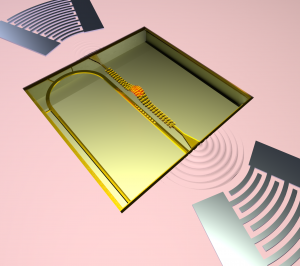Researchers have designed a novel computer and telecommunication technology utilising nano-electro-opto-mechanical system (NEOMS).
Researchers use phonons – i .e. mechanical vibrations – as information carriers, together with electrons and photons, in a novel nano-electro-opto-mechanical system (NEOMS) platform, which can operate at room temperature and frequencies up to a few GHz to create multi-signal systems.
Based on nanocrystalline-silicon, it is fully compatible with CMOS technologies, facilitating integration with current silicon electronics. This work, recently published in ACS Photonics, has been carried out within the EU-H2020-FET Open project PHENOMEN.
The key components of this NEOMS platform were developed by a team of researchers from the Catalan Institute on Nanoscience and Nanotechnology at the Universitat Autonoma de Barcelona (UAB), CNR-Nano (Pisa, Italy), the Polytechnic University of Valencia (Spain) and the VTT Technical Research Centre (Espoo, Finland).

Phonon-based signal processing system
Current computer and telecommunication technologies use electrical charges (electrons) and light (photons) to transport information. However, a breakthrough in this field could be brought about by the introduction of mechanical vibrations – phonons – as a means of transferring data, in combination with the electrons and photons.
In order to establish the basis for this new information technology, the researchers involved in the PHENOMEN project worked for almost four years on the development of a phonon-based signal processing system that could be incorporated in standard electronic chips.
The outcomes of this study have been recently published in a paper in ACS Photonics introducing a proof-of-concept technology platform for the integration of phononic, photonic and radio-frequency (RF) electronic signals, which can be operated at ambient conditions and is fully compatible with CMOS technology. These remarkable results open new avenues for information processing and transport, not only in current IT applications, but also in future quantum networks.
Establishing a coherent phonon source
The researchers engineered a coherent phonon source using the opto-mechanical coupling mechanism, namely the interaction of radiation pressure forces with a resonator. The microscale resonator was designed to simultaneously sustain co-localised optical and mechanical modes. The phonon source results from an opto-mechanical interaction involving competing mechanisms: one arising from the photo-generated carriers in the resonator and the other from the temperature variation of the resonator impacting its optical properties. This interaction leads to the generation of coherent vibrations, i.e., acoustic waves in-phase with each other.
The core material used to maximise the opto-mechanical interaction is nanocrystalline silicon (nc-Si), a technology developed at VTT – instead of standard crystalline silicon (c-Si) –, which provides various advantages, such as: flexibility in tuning optical, mechanical and thermal property of the system; and increased affordability, since the components can be fabricated on standard silicon wafers.
The conversion of electrical signals into mechanical waves is achieved by combining silicon with aluminium nitride (AlN), which is a piezoelectric material – i.e. a material able to produce electricity upon application of mechanical stress. Both solutions represent a great innovation in the design and fabrication of NOEMS.
Novel silicon-compatible platform for nano-electro-opto-mechanical systems
This novel silicon-compatible platform for nano-electro-opto-mechanical systems, which enables the conversion of electric signals into optical ones via mechanical waves (and vice versa), was shown to operate at radio-frequencies (up to a few GHz) and at room temperature, thus it can be incorporated in CMOS fabrication processes. Therefore, it has the potential to become a groundbreaking solution for new, multifunctional, and multi-signal technologies for information transmission and processing, both in the classic and the quantum domain.









